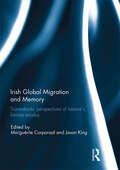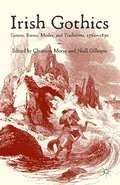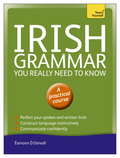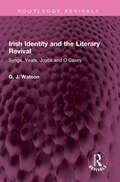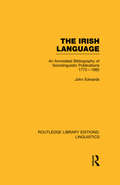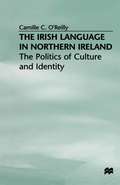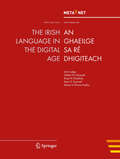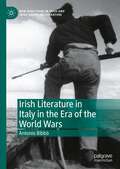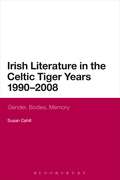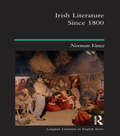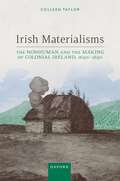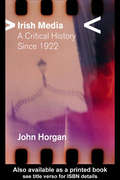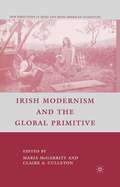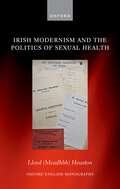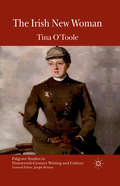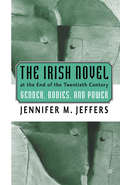- Table View
- List View
Irish Global Migration and Memory: Transatlantic Perspectives of Ireland's Famine Exodus
by Marguérite Corporaal Jason KingIrish Global Migration and Memory: Transnational Perspectives of Ireland’s Famine Exodus brings together leading scholars in the field who examine the experiences and recollections of Irish emigrants who fled from their famine-stricken homeland in the mid-nineteenth century. The book breaks new ground in its comparative, transnational approach and singular focus on the dynamics of cultural remembrance of one migrant group, the Famine Irish and their descendants, in multiple Atlantic and Pacific settings. Its authors comparatively examine the collective experiences of the Famine Irish in terms of their community and institution building; cultural, ethnic, and racial encounters with members of other groups; and especially their patterns of mass-migration, integration, and remembrance of their traumatic upheaval by their descendants and host societies. The disruptive impact of their mass-arrival had reverberations around the Atlantic world. As an early refugee movement, migrant community, and ethnic minority, Irish Famine emigrants experienced and were recollected to have faced many of the challenges that confronted later immigrant groups in their destinations of settlement. This book is especially topical and will be of interest not only to Irish, migration, and refugee scholars, but also the general public and all who seek to gain insight into one of Europe’s foundational moments of forced migration that prefigures its current refugee crisis.This book was originally published as a special issue of Atlantic Studies: Global Currents.
Irish Global Migration and Memory: Transatlantic Perspectives of Ireland's Famine Exodus
by Marguérite Corporaal Jason KingIrish Global Migration and Memory: Transnational Perspectives of Ireland’s Famine Exodus brings together leading scholars in the field who examine the experiences and recollections of Irish emigrants who fled from their famine-stricken homeland in the mid-nineteenth century. The book breaks new ground in its comparative, transnational approach and singular focus on the dynamics of cultural remembrance of one migrant group, the Famine Irish and their descendants, in multiple Atlantic and Pacific settings. Its authors comparatively examine the collective experiences of the Famine Irish in terms of their community and institution building; cultural, ethnic, and racial encounters with members of other groups; and especially their patterns of mass-migration, integration, and remembrance of their traumatic upheaval by their descendants and host societies. The disruptive impact of their mass-arrival had reverberations around the Atlantic world. As an early refugee movement, migrant community, and ethnic minority, Irish Famine emigrants experienced and were recollected to have faced many of the challenges that confronted later immigrant groups in their destinations of settlement. This book is especially topical and will be of interest not only to Irish, migration, and refugee scholars, but also the general public and all who seek to gain insight into one of Europe’s foundational moments of forced migration that prefigures its current refugee crisis.This book was originally published as a special issue of Atlantic Studies: Global Currents.
Irish Gothics: Genres, Forms, Modes, and Traditions, 1760-1890
by Christina Morin Niall GillespieScholarly interest in 'the Irish Gothic' has grown at a rapid pace in recent years, but the debate over exactly what constitutes this body of literature remains far from settled. This collection of essays explores the rich complexities of the literary gothic in eighteenth- and nineteenth-century Ireland.
Irish Grammar You Really Need to Know: Teach Yourself (Teach Yourself Language Reference)
by Éamonn Ó DónaillComprehensive and clear explanations of key grammar patterns and structures are reinforced and contextualized through authentic materials. You will not only learn how to construct grammar correctly, but when and where to use it so you sound natural and appropriate. Irish Grammar You Really Need to Know will help you gain the intuition you need to become a confident communicator in your new language.
Irish Identity and the Literary Revival: Synge, Yeats, Joyce and O'Casey (Routledge Revivals)
by George WatsonFirst published in 1979, Irish Identity and the Literary Revival, through the works of W.B. Yeats, James Joyce, J. M. Synge, and Sean O’Casey, documents the complex spectrum of political, social and other pressures that helped fashion modern Ireland. At least three sets of cultural assumptions coexisted in Ireland during the years between 1890 and 1930, -- English, Irish and Anglo-Irish, each united by a common language but divided by considerable tensions and strain. The question of Irish identity forms the central theme of the study, and illustrates how it was a major, even obsessive concern for these writers. Subsidiary and interwoven themes constantly recur. Themes such as the concepts of the peasant and the hero, political nationalism, the meaning of Ireland’s history and the validity of her cultural traditions. Rather than use the literature concerned as merely endorsing evidence for a sociological or political thesis, this study allows its major themes and issues to emerge and develop from direct and close study of the work of the writers. This book will be of interest to students of literature and history.
Irish Identity and the Literary Revival: Synge, Yeats, Joyce and O'Casey (Routledge Revivals)
by George WatsonFirst published in 1979, Irish Identity and the Literary Revival, through the works of W.B. Yeats, James Joyce, J. M. Synge, and Sean O’Casey, documents the complex spectrum of political, social and other pressures that helped fashion modern Ireland. At least three sets of cultural assumptions coexisted in Ireland during the years between 1890 and 1930, -- English, Irish and Anglo-Irish, each united by a common language but divided by considerable tensions and strain. The question of Irish identity forms the central theme of the study, and illustrates how it was a major, even obsessive concern for these writers. Subsidiary and interwoven themes constantly recur. Themes such as the concepts of the peasant and the hero, political nationalism, the meaning of Ireland’s history and the validity of her cultural traditions. Rather than use the literature concerned as merely endorsing evidence for a sociological or political thesis, this study allows its major themes and issues to emerge and develop from direct and close study of the work of the writers. This book will be of interest to students of literature and history.
The Irish Language: AN Annotated Bibliography of Sociolinguistic Publications 1772-1982 (Routledge Library Editions: Linguistics)
by John EdwardsIn compiling this bibliography, the main purpose was to assemble references to published material of a sociolinguistic nature concerning the Irish language. The intent was not to cover publications treating language per se, but rather to consider those dealing with language in its social context. Represented here are articles, chapters, books and pamphlets bearing upon social, historical, psychological and educational aspects of Irish – including the decline of the language, the restoration effort, the relationship of language to nationality and religion, and studies of important figures in the language movement.
The Irish Language: AN Annotated Bibliography of Sociolinguistic Publications 1772-1982 (Routledge Library Editions: Linguistics)
by John EdwardsIn compiling this bibliography, the main purpose was to assemble references to published material of a sociolinguistic nature concerning the Irish language. The intent was not to cover publications treating language per se, but rather to consider those dealing with language in its social context. Represented here are articles, chapters, books and pamphlets bearing upon social, historical, psychological and educational aspects of Irish – including the decline of the language, the restoration effort, the relationship of language to nationality and religion, and studies of important figures in the language movement.
The Irish Language in Northern Ireland: The Politics of Culture and Identity
by Camille C. O'ReillyA topical and authoritative investigation of the Irish language and identity in Northern Ireland. The phrase 'our own language' has come to symbolize the importance of the Irish language to Irish identity for many Nationalists in Northern Ireland. However, different interests compete to have their version of the meaning and importance of the Irish language accepted. This book investigates the role of the Irish language movement in the social construction of competing versions of Irish political and cultural identity in Northern Ireland, arguing that for some Nationalists, the Irish language has become an alternative point of political access and expression.
The Irish Language in the Digital Age (White Paper Series)
by Georg Rehm Hans UszkoreitThis white paper is part of a series that promotes knowledge about language technology and its potential. It addresses educators, journalists, politicians, language communities and others. The availability and use of language technology in Europe varies between languages. Consequently, the actions that are required to further support research and development of language technologies also differ for each language. The required actions depend on many factors, such as the complexity of a given language and the size of its community. META-NET, a Network of Excellence funded by the European Commission, has conducted an analysis of current language resources and technologies. This analysis focused on the 23 official European languages as well as other important national and regional languages in Europe. The results of this analysis suggest that there are many significant research gaps for each language. A more detailed expert analysis and assessment of the current situation will help maximise the impact of additional research and minimize any risks. META-NET consists of 54 research centres from 33 countries that are working with stakeholders from commercial businesses, government agencies, industry, research organisations, software companies, technology providers and European universities. Together, they are creating a common technology vision while developing a strategic research agenda that shows how language technology applications can address any research gaps by 2020.
Irish Literature in Italy in the Era of the World Wars (New Directions in Irish and Irish American Literature)
by Antonio BibbòThis book addresses both the dissemination and increased understanding of the specificity of Irish literature in Italy during the first half of the twentieth century. This period was a crucial time of nation-building for both countries. Antonio Bibbò illustrates the various images of Ireland that circulated in Italy, focusing on political and cultural discourses and examines the laborious formation of an Irish literary canon in Italy. The center of this analysis relies on books and articles on Irish politics, culture, and literature produced in Italy, including pamplets, anthologies, literary histories, and propaganda; translations of texts by Irish writers; and archival material produced by writers, publishers, and cultural and political institutions. Bibbò argues that the construction of different and often conflicting ideas of Ireland in Italy as well as the wavering understanding of the distinctiveness of Irish culture, substantially affected the Italian responses to Irish writers and their presence within the Italian publishing field. This book contributes to the discussion on transnational aspects of canon formation, reception studies, and Italian cultural studies.
Irish Literature in the Celtic Tiger Years 1990 to 2008: Gender, Bodies, Memory (Continuum Literary Studies)
by Susan CahillWhen Irish culture and economics underwent rapid changes during the Celtic Tiger Years, Anne Enright, Colum McCann and Éilís Ní Dhuibhne began writing. Now that period of Irish history has closed, this study uncovers how their writing captured that unique historical moment. By showing how Ní Dhuibhne's novels act as considered arguments against attempts to disavow the past, how McCann's protagonists come to terms with their history and how Enright's fiction explores connections and relationships with the female body, Susan Cahill's study pinpoints common concerns for contemporary Irish writers: the relationship between the body, memory and history, between generations, and between past and present. Cahill is able to raise wider questions about Irish culture by looking specifically at how writers engage with the body. In exploring the writers' concern with embodied histories, related questions concerning gender, race, and Irishness are brought to the fore. Such interrogations of corporeality alongside history are imperative, making this a significant contribution to ongoing debates of feminist theory in Irish Studies.
Irish Literature in the Celtic Tiger Years 1990 to 2008: Gender, Bodies, Memory (Continuum Literary Studies)
by Susan CahillWhen Irish culture and economics underwent rapid changes during the Celtic Tiger Years, Anne Enright, Colum McCann and Éilís Ní Dhuibhne began writing. Now that period of Irish history has closed, this study uncovers how their writing captured that unique historical moment. By showing how Ní Dhuibhne's novels act as considered arguments against attempts to disavow the past, how McCann's protagonists come to terms with their history and how Enright's fiction explores connections and relationships with the female body, Susan Cahill's study pinpoints common concerns for contemporary Irish writers: the relationship between the body, memory and history, between generations, and between past and present. Cahill is able to raise wider questions about Irish culture by looking specifically at how writers engage with the body. In exploring the writers' concern with embodied histories, related questions concerning gender, race, and Irishness are brought to the fore. Such interrogations of corporeality alongside history are imperative, making this a significant contribution to ongoing debates of feminist theory in Irish Studies.
Irish Literature Since 1800
by Norman VanceThis book surveys Irish writing in English over the last two centuries, from Maria Edgeworth to Seamus Heaney, to give the literary student and the general reader an up-to-date sense of its variety and vitality and to indicate some of the ways in which it has been described and discussed. It begins with a brief outline of Irish history, of Irish writing in Irish and Latin, and of writing in English before 1800. Later chapters consider Irish romanticism, Victorian Ireland, W.B.Yeats and the Irish Literary Revival, new directions in Irish writing after Joyce and the literature of contemporary Ireland, north and south, from 1960 to the present.
Irish Literature Since 1800
by Norman VanceThis book surveys Irish writing in English over the last two centuries, from Maria Edgeworth to Seamus Heaney, to give the literary student and the general reader an up-to-date sense of its variety and vitality and to indicate some of the ways in which it has been described and discussed. It begins with a brief outline of Irish history, of Irish writing in Irish and Latin, and of writing in English before 1800. Later chapters consider Irish romanticism, Victorian Ireland, W.B.Yeats and the Irish Literary Revival, new directions in Irish writing after Joyce and the literature of contemporary Ireland, north and south, from 1960 to the present.
Irish Materialisms: The Nonhuman and the Making of Colonial Ireland, 1690–1830
by Colleen TaylorIrish Materialisms: The Nonhuman and the Making of Colonial Ireland, 1690-1830, is the first book to apply recent trends in new materialist criticism to Ireland. It radically shifts familiar colonial stereotypes of the feminized, racialized cottier according to the Irish peasantry's subversive entanglement with nonhuman materiality. Each of the chapters engages a focused case study of an everyday object in colonial Ireland (coins, flax, spinning wheels, mud, and pigs) to examine how each object's unique materiality contributed to the colonial ideology of British paternalism and afforded creative Irish expression. The main argument of Irish Materialisms is its methodology: of reading literature through the agency of materiality and nonhuman narrative in order to gain a more egalitarian and varied understanding of colonial experience. Irish Materialisms proves that new materialism holds powerful postcolonial potential. Through an intimate understanding of the materiality Irish peasants handled on a daily basis, this book presents a new portrait of Irish character that reflects greater empowerment, resistance, and expression in the oppressed Irish than has been previously recognized.
Irish Materialisms: The Nonhuman and the Making of Colonial Ireland, 1690–1830
by Colleen TaylorIrish Materialisms: The Nonhuman and the Making of Colonial Ireland, 1690-1830, is the first book to apply recent trends in new materialist criticism to Ireland. It radically shifts familiar colonial stereotypes of the feminized, racialized cottier according to the Irish peasantry's subversive entanglement with nonhuman materiality. Each of the chapters engages a focused case study of an everyday object in colonial Ireland (coins, flax, spinning wheels, mud, and pigs) to examine how each object's unique materiality contributed to the colonial ideology of British paternalism and afforded creative Irish expression. The main argument of Irish Materialisms is its methodology: of reading literature through the agency of materiality and nonhuman narrative in order to gain a more egalitarian and varied understanding of colonial experience. Irish Materialisms proves that new materialism holds powerful postcolonial potential. Through an intimate understanding of the materiality Irish peasants handled on a daily basis, this book presents a new portrait of Irish character that reflects greater empowerment, resistance, and expression in the oppressed Irish than has been previously recognized.
Irish Media: A Critical History since 1922
by John HorganIrish Media: A Critical History maps the landscape of media in Ireland from the foundation of the modern state in 1922 to the present. Covering all principal media forms, print and electronic, in the Republic and in Northern Ireland, John Horgan shows how Irish history and politics have shaped the media of Ireland and, in turn, have been shaped by them.Beginning in a country ravaged by civil war, it traces the complexities of wartime censorship and details the history of media technology, from the development of radio to the inauguration of television in the 1950s and 1960s. It covers the birth, development and - sometimes - the death of major Irish media during this period, examining the reasons for failure and success, and government attempts to regulate and respond to change. Finally, it addresses questions of media globalisation, ownership and control, and looks at issues of key significance for the future.Horgan demonstrates why, in a country whose political divisions and economic development have given it a place on the world stage out of all proportion to its size, the media have been and remain key players in Irish history.
Irish Media: A Critical History since 1922
by John HorganIrish Media: A Critical History maps the landscape of media in Ireland from the foundation of the modern state in 1922 to the present. Covering all principal media forms, print and electronic, in the Republic and in Northern Ireland, John Horgan shows how Irish history and politics have shaped the media of Ireland and, in turn, have been shaped by them.Beginning in a country ravaged by civil war, it traces the complexities of wartime censorship and details the history of media technology, from the development of radio to the inauguration of television in the 1950s and 1960s. It covers the birth, development and - sometimes - the death of major Irish media during this period, examining the reasons for failure and success, and government attempts to regulate and respond to change. Finally, it addresses questions of media globalisation, ownership and control, and looks at issues of key significance for the future.Horgan demonstrates why, in a country whose political divisions and economic development have given it a place on the world stage out of all proportion to its size, the media have been and remain key players in Irish history.
Irish Modernism and the Global Primitive (New Directions in Irish and Irish American Literature)
by Maria McGarrity C. CulletonThis book scrutinizes the way modern Irish writers exploited or surrendered to primitivism, and how primitivism functions as an idealized nostalgia for the past as a potential representation of difference and connection.
Irish Modernism and the Politics of Sexual Health (Oxford English Monographs)
by Lloyd (Meadhbh) HoustonIrish Modernism and the Politics of Sexual Health explores the politicized role of sexual health as a concept, discourse, and subject of debate within Irish literary culture from 1880 to 1960. Combining perspectives from Irish Studies, Modernist Studies, and the Social History of Medicine, it traces the ways in which authors, politicians, and activists in nineteenth- and twentieth-century Ireland harnessed debates over sexual hygiene, venereal disease, birth control, fertility, and eugenics to envisage competing models of Irish identity, culture, and political community. Analyzing the work of canonical authors (Yeats, Synge, Shaw, Joyce, Beckett, Flann O'Brien) and less often discussed figures (George Moore, Oliver Gogarty, Signe Toksvig, Kate O'Brien) in conversation with medical, scientific, and legal writing on sexual health, it charts how the medicalization and politicization of sex informed the emergence and development of modernism in Ireland. At the same time, by reading this literary material alongside the polemical and journalistic writing of figures such as Arthur Griffith, Maud Gonne, and Hanna Sheehy-Skeffington, it also reveals the ways in which key events in Irish cultural and political history - the Parnell Split, the Limerick Pogrom, the Playboy riots, the passage of the Censorship of Publications Act - were shaped by ongoing debates and dilemmas in the field of sexual health. This book will benefit students, researchers, and readers interested in the history of sex and its regulation in modern Ireland, the impact of sex and medicine on Irish political history, and the nature of modernism's engagement with sex, health, and the body.
Irish Modernism and the Politics of Sexual Health (Oxford English Monographs)
by Lloyd (Meadhbh) HoustonIrish Modernism and the Politics of Sexual Health explores the politicized role of sexual health as a concept, discourse, and subject of debate within Irish literary culture from 1880 to 1960. Combining perspectives from Irish Studies, Modernist Studies, and the Social History of Medicine, it traces the ways in which authors, politicians, and activists in nineteenth- and twentieth-century Ireland harnessed debates over sexual hygiene, venereal disease, birth control, fertility, and eugenics to envisage competing models of Irish identity, culture, and political community. Analyzing the work of canonical authors (Yeats, Synge, Shaw, Joyce, Beckett, Flann O'Brien) and less often discussed figures (George Moore, Oliver Gogarty, Signe Toksvig, Kate O'Brien) in conversation with medical, scientific, and legal writing on sexual health, it charts how the medicalization and politicization of sex informed the emergence and development of modernism in Ireland. At the same time, by reading this literary material alongside the polemical and journalistic writing of figures such as Arthur Griffith, Maud Gonne, and Hanna Sheehy-Skeffington, it also reveals the ways in which key events in Irish cultural and political history - the Parnell Split, the Limerick Pogrom, the Playboy riots, the passage of the Censorship of Publications Act - were shaped by ongoing debates and dilemmas in the field of sexual health. This book will benefit students, researchers, and readers interested in the history of sex and its regulation in modern Ireland, the impact of sex and medicine on Irish political history, and the nature of modernism's engagement with sex, health, and the body.
Irish/ness Is All Around Us: Language Revivalism and the Culture of Ethnic Identity in Northern Ireland (Integration and Conflict Studies #6)
by Olaf ZenkerFocusing on Irish speakers in Catholic West Belfast, this ethnography on Irish language and identity explores the complexities of changing, and contradictory, senses of Irishness and shifting practices of 'Irish culture' in the domains of language, music, dance and sports. The author’s theoretical approach to ethnicity and ethnic revivals presents an expanded explanatory framework for the social (re)production of ethnicity, theorizing the mutual interrelations between representations and cultural practices regarding their combined capacity to engender ethnic revivals. Relevant not only to readers with an interest in the intricacies of the Northern Irish situation, this book also appeals to a broader readership in anthropology, sociology, cultural studies, history and political science concerned with the mechanisms behind ethnonational conflict and the politics of culture and identity in general.
The Irish New Woman (Palgrave Studies in Nineteenth-Century Writing and Culture)
by Tina O'TooleThe Irish New Woman explores the textual and ideological connections between feminist, nationalist and anti-imperialist writing and political activism at the fin de siècle . This is the first study which foregrounds the Irish and New Woman contexts, effecting a paradigm shift in the critical reception of fin de siècle writers and their work.
The Irish Novel at the End of the Twentieth Century: Gender, Bodies and Power
by J. JeffersThe Irish Novel at the End of the Twentieth Century: Gender, Bodies and Power interprets a wide variety of the most interesting Irish novels of the last ten years of the century from a perspective that focuses on the regulated sexual and constructed gendered body. The demarcating line of identity-the perennial Irish problem-can be gauged at the basic level of sexual and gender identity in contrast to or in alliance with political, social, religious or cultural norms. All mechanisms that have gone into controlling the body-gender regulation, violence, desire, religious taboos-can all be reinterpreted through the body in motion.
